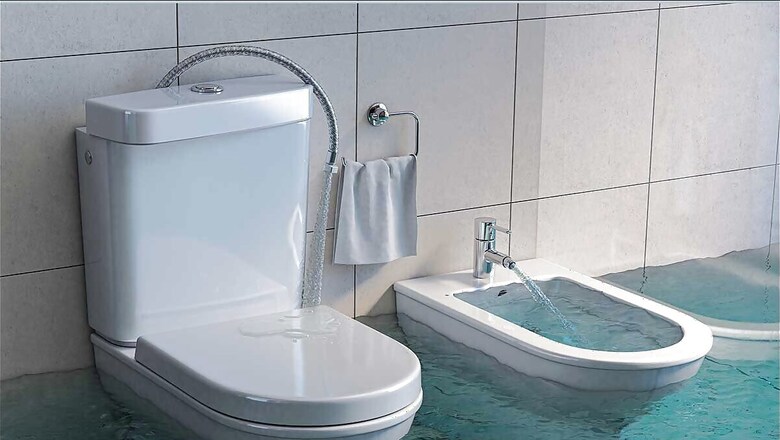
views
India is a land where identity takes on many, many layers. We’re also a country that has made extraordinary strides in inclusiveness – over the years, we have worked to uplift communities that have faced extreme prejudice, communities that have not had a voice, communities that were economically backward, communities that lived in places where access was an issue. We have done this through targeted government and economic programs, and lately, through large programs like the Swachh Bharat Mission, that has brought about a marked improvement in health outcomes for an entire nation, by democratising toilet access for every Indian.
Traditionally, however, Indian sanitation facilities have been built around a binary gender perspective, providing toilets for men and women. This leaves out non-binary individuals, intersex and transgender people, and other members of the LGBTQ+ community.
The toilet, a seemingly simple amenity, becomes a daily challenge for these individuals, who have to navigate the fear of humiliation, harassment, or even physical violence. In the monsoons, when rains create flooding and other damage to toilets, this becomes an even bigger problem because gender non-conforming individuals have to venture outside their communities just to go to the toilet – exposing them to greater risk.
The ‘Wrong’ Toilet and it’s Mental, Physical, and Economic Impacts
For gender non-conforming people, a gender segregated toilet gives them no place to go. Whether they choose to use the men’s toilet or the ladies’ toilet, they are, in essence, in the ‘wrong’ toilet, and therefore at risk of ridicule and harassment, in addition to the ever present threat of physical confrontation.
A study conducted in the United States revealed that 59% of transgender or gender-diverse participants avoided using public toilets due to fear of confrontations. According to another study, among the transgender and/or nonbinary youth who experienced bathroom discrimination, 85% reported depressive mood and 60% seriously considered suicide. These experiences are echoed by transgender and non-binary people everywhere, including India.
And that’s not all. There are physical repercussions too. Many transgender and/or non-binary people prefer to ‘hold it’ than subject themselves to the indignity of going to a toilet where they aren’t welcome. As we know, this can lead to the development of urinary tract infections, kidney problems, and other related health issues. Moreover, many of them also resort to restricting their food and water intake. This can and, with our weather, often does lead to dehydration.
This in turn, leads to greater sick days – be it during education or during work life. As we know from Mark Balla’s story, girls often drop out from school once they begin menstruation when they don’t have access to a clean and safe toilet. The same reasoning extends to transgender and non-binary people who menstruate. Moreover, think about how productive you would be if you were going to:
- Figure out how much you need to eat or drink so that you don’t have to go to the toilet.
- Figure out when the toilet is empty, so the chances of you being confronted are minimal.
- Figure out which toilet to go to.
Creating Safe, Inclusive Spaces that are Monsoon-Proof
While this isn’t a one-size-fits-all solution, gender neutral bathrooms are generally considered the most cost effective, safe and inclusive solution. These facilities are not designated as male or female and can be used by anyone regardless of gender. No one gets stopped from using these, because it doesn’t matter how you identify – these are spaces that welcome us all. This can be done via clear signage, and through inclusive design principles.
Multi-user gender-neutral toilets can adopt various models. The men’s room model incorporates both conventional urinals and toilet stalls, providing options for different users. The women’s room model focuses on conventional toilet stalls only, removing the urinals. The family toilet model includes multiple gender-inclusive toilet rooms along with shared space for handwashing.
However, it doesn’t stop there. Inclusive toilets are prone to the same issues that gendered toilets have during the monsoon: lashing, heavy rains can cause flooding, overflowing toilets, structural damage, etc. We are increasingly seeing greater impacts of climate change – each year, the monsoon has been heavier, more unpredictable, and more destructive. Monsoon-proof infrastructure isn’t something to ‘aspire’ to, it is the need of the hour.
Designing For The Monsoon
To address these challenges, resilient toilets should be designed with specific features and principles in mind. Some key design principles that have worked well worldwide are:
- Elevated Structures: that help prevent floodwaters from entering the structure.
- Flood-Resistant Materials: like reinforced concrete or fibre-reinforced plastic can increase the durability and longevity of the toilets.
- Proper Drainage Systems: and waste management systems can handle increased flow (during flooding) and prevent the contamination of local water bodies.
- Reinforced Foundations: are better able to withstand the pressure exerted by floodwaters and can provide the necessary stability, preventing structural damage.
- Ventilation and Natural Lighting: can help prevent the growth of bacteria, reduce odours, and create a pleasant user experience.
Educating Users and Creating a Maintenance Plan
In India, where we see sanitation work as work that is ‘beneath’ us, there is an enormous education and awareness gap where toilet hygiene and maintenance is concerned. This is exactly why Harpic, a leader in the lavatory care segment, has been toiling away all these years, to build a knowledge base around this neglected area of home care. Over the years, Harpic has built strong communication strategies around the need for good toilet hygiene habits in particular, and sanitation overall, through thought provoking campaigns and outreach programs.
Harpic also joined hands with News18 to create Mission Swachhta aur Paani, a movement that upholds the cause of inclusive sanitation where everyone has access to clean toilets. For 3 years now, this initiative has advocated equality for all genders, abilities, castes and classes and championed the cause that clean toilets are a shared responsibility. Clean and safe toilets for all means that our communities are healthier, our children spend more days in school and less days out sick, girls don’t drop out of school, our workplaces are more diverse places, and that our cities and towns are cleaner, safer, and more welcoming.
Mission Swachhta aur Paani is creating repositories of information on every conceivable topic around toilet use, and how it impacts us individually, as well as the larger society. You’ll find use case specific information pertaining to gender neutral toilets, monsoon proofing toilets, making toilets more accessible, design innovations that make toilets more sustainable and less polluting, and many, many others.
It’s never been easier for any of us to take action, and Mission Swachhta aur Paani is empowering us with information we need to do so. Join us here to learn how you can contribute to the creation of a more equal, more just and more safe Bharat.



















Comments
0 comment